(Listed Alphabetically)
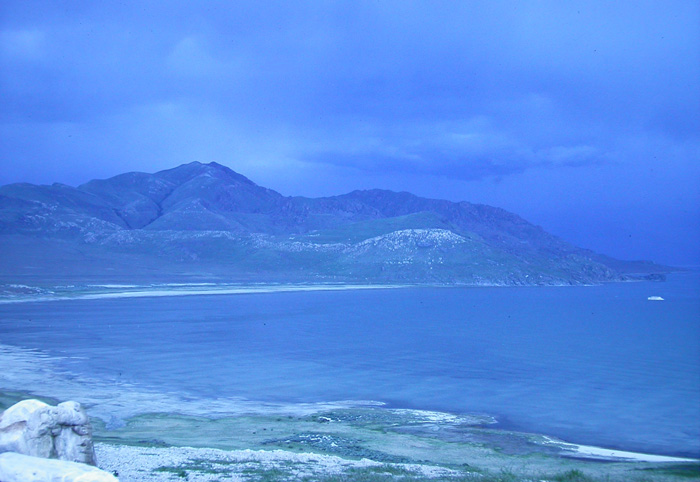 |
|
Antelope Island State Park
photo by Merrill Webb |
1. Antelope Island
State Park and
Causeway
Nothing matches the spectacle of seeing hundreds of thousands of
Eared Grebes and Wilson's Phalaropes feeding on the Gt. Salt Lake.
Thousands of American Avocets, and hundreds of assorted other shore
birds like the Black-necked Stilt and Western Sandpipers can be observed
during spring and fall migrations. Impressive numbers of Black-bellied
Plovers, Sanderlings, and Bonaparte's Gulls can be observed during
migration as well. It is like no other experience you can have in Utah
in terms of total numbers of birds. There is a nominal fee since it is a
state park.
Since you are this close to Antelope Island you might as well
continue your trip to the island and look for Chukar, Burrowing Owl,
Barn Owl, and Grasshopper Sparrow. At Garr Ranch, farther south from the
visitor's center, especially during spring and fall migration, there are
a variety of songbirds to be looked for. Northern Waterthrush, Wilson's,
Townsend's, Black-and-White and Magnolia Warblers have all been seen
here. And if the hummingbird feeders are in place the Rufous Hummingbird
plus another couple of species of hummers can be easily observed.
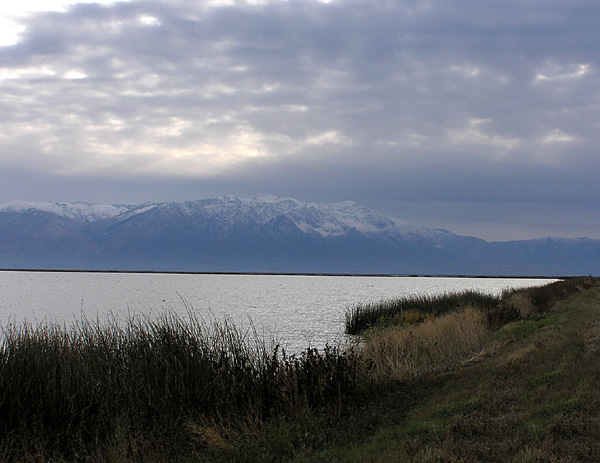 |
|
Bear River MBR
photo by Eric Huish |
2. Bear River Migratory Bird Refuge
If you like waterfowl (and shorebirds) this federally managed refuge is
a must see place. Thousands of ducks, i.e., Northern Pintail, Northern
Shoveler, Green-wing Teal, and Gadwall can be observed during migration.
Flocks of Marbled Godwits, Long-billed Dowitchers, Willets and peeps
cover the mudflats during the same time. During the late spring and into
the summer you can observe the courtship antics of the Western Grebe and
also observe the colorful Ruddy Duck. During the winter months, the
unmistakable calls of thousands of Tundra Swans fill the cold, crisp
air. And its free.
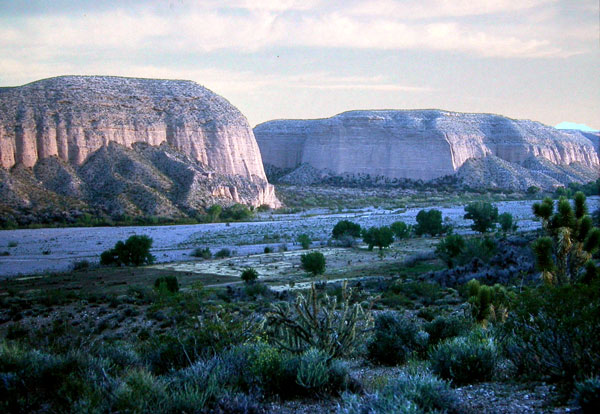 |
|
Beaver Dam Wash
photo by Merrill Webb |
3. Beaver Dam Wash
There are about ten species of Mohave Desert birds that make their home
in the southwestern corner of the state. No one who is serious about
keeping a state bird list should die before visiting
Lytle Ranch
Preserve, owned by Brigham Young University. Located northwest of St.
George, the ranch can be accessed by traveling on a graded gravel road
once you leave the main highway at a place that used to be called
"Castle Cliff". Consult a map for directions. On the drive to the ranch
watch for Cactus Wren and Black-throated Sparrow as well as the
occasional Loggerhead Shrike which hunts from the tops of Joshua Trees.
Birds that can be found at the preserve include the uncommon Common
Black Hawk, White-winged Dove, Costa's Hummingbird, Phainopepla, Summer
Tanager, Black-tailed Gnatcatcher, Brown-crested Flycatcher, Verdin,
Lucy's Warbler and Bell's Vireo. April is the best time to visit because
it isn't too hot, yet, and the birds are vocalizing. But you need to be
there early (before 10:00 AM) for best results. Other species to look
for are the Greater Roadrunner, Gambel's Quail, Ladder-back Woodpecker,
Crissal Thrasher, Blue Grosbeak and Hooded Oriole. When the figs are
rips as many as three species of orioles are possible as they come in to
feed on the ripe fruit. Persimmons ripen by late fall, and the Red-naped
Sapsuckers move in to feed on the fruit, which then attracts the large,
golden-winged Tarantula Hawks, wasps that feed on the juice made
accessible by the woodpeckers. At night listen for the Western Screech
Owl, Great Horned Owl and Common Poorwill. If you visit during fall
migration, eastern vagrants should be looked for. Lytle Ranch Preserve
really is a jewel in the desert.
4. Deseret Ranch
Located mostly in Rich County in northern Utah Deseret Ranch offers a
great diversity of birds and harbors one of the largest populations of
Greater Sage Grouse in Utah. The problem here is access--and I'm not
referring to automobile access. A couple of instate birders have
purchased the "rights of admission" so to speak. In order to check out
the birds on the greater portion of the ranch a fee is charged by the
individual who serves as your guide on the property. [email
for information]
It is a great place to find unusual migrating birds, especially
warblers and shorebirds. But if you don't mind visiting other places in
the state I will mention you can find most of the same birds. It just
takes longer. Depends on the state of your health, I suppose.
5.
Devil's Canyon Campground and
Recapture Reservoir
In southeastern Utah, driving on State Highway 191 between Monticello
and Blanding takes the birder through extensive stands of Ponderosa Pine
forest. Devil's Canyon Campground is a favored stop along the way
because finding three species of nuthatches (Pygmy, Red-breasted and
White-Breasted) is a real possibility. Plus, this area is probably the
most consistent location in the state to observe the Acorn Woodpecker.
Other woodpecker species to look for are the Hairy, Downy and the Red-naped
Sapsucker. A short distance farther south on the highway toward Blanding
is Recapture Reservoir, a favorite stop-over for migrating water birds
such as mergansers, grebes and Common Loons.
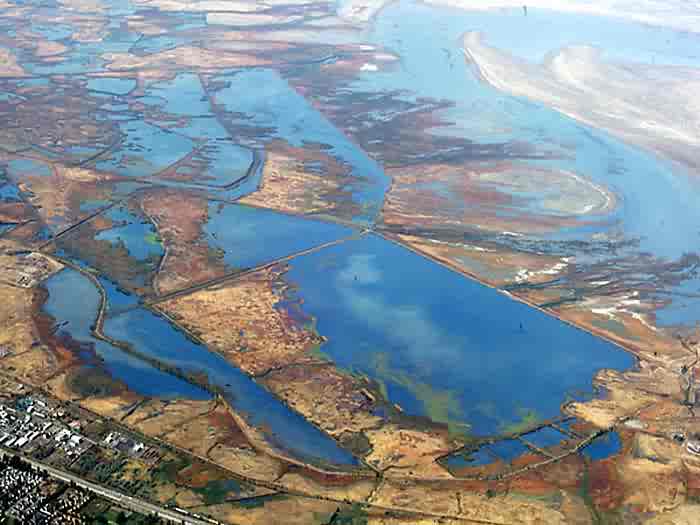 |
|
Farmington Bay
photo by Jack Binch |
6. Farmington Bay Waterfowl Management Area
During the winter months, this state-managed waterfowl area is the best
place in the state to observe large numbers of Bald Eagles as they move
in for a free lunch of dead carp. Numbers seem to peak during the last
of January to the middle of February, so if you like watching eagles,
this is the best time and place to go visit. Located on the east shore
of the Gt. Salt Lake this management area is just a short drive from
major population centers along the Wasatch Front.
During your winter visit there are usually three or four species of
gulls on which to practice your identification skills.
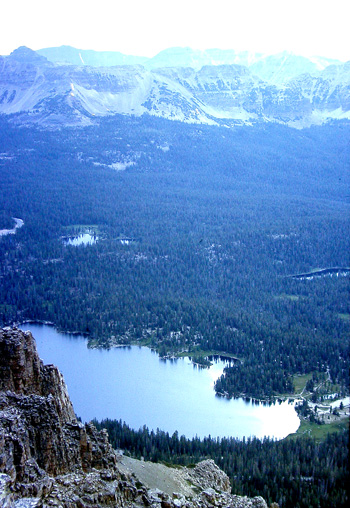 |
|
Mirror Lake from Mt. Baldy
photo by Merrill Webb |
During the summer months watch for Common Moorhen, American Bittern,
Virginia Rail and Sora. Much more common, though, are Marsh Wrens,
Cinnamon Teal and Canada Geese, all of which are common nesting species.
7. The High Uintas
For beautiful mountain scenery the drive east from Kamas on the
Mirror Lake highway through forests of pinion-juniper, aspen, and
finally spruce-fir is a favorite of most instate birders. Plus, this is
the best location in the state to observe a variety of high alpine
forest birds in a centrally located area. Around the
Mirror Lake
camping area, Gray Jay, Clark's Nutcracker, Pine Grosbeaks and
Three-toed Woodpeckers are fairly easy to find. And at certain times of
the year, with luck, the Black-rosy Finch can be observed foraging in
the snowfields along Mt. Baldy pass. Red Crossbills and Pine Siskins can
usually be observed in the tops of conifers where they extract seeds
from the cones.
8. Quail Creek Reservoir, Grandpa's (Stratton's) Pond and Hurricane
Water Treatment Ponds
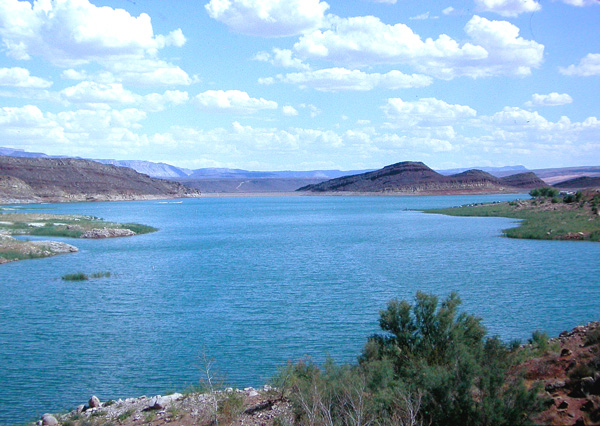 |
|
Quail Creek Reservoir
photo by Merrill Webb |
Within a couple of miles of each other in the Virgin River drainage,
and located between St. George and Hurricane in Washington County, are
three man-made bodies of water which attract many different species of
water birds, especially during the winter months. These are the places
to go if you want to perfect your identification skills on ducks because
most of them are here.
At Quail Creek reservoir diving ducks such as Common Goldeneye and
Bufflehead are common. Double-crested Cormorants, Eared and Western
Grebes, although not considered waterfowl, can also be observed.
Just to the south on the other side of the earth-filled dam is
Stratton's, now called Grandpa's, Pond. There is always a good variety
of waterfowl here such as Hooded Merganser, Greater and Lesser Scaup,
American Wigeon, and an occasional Red-head or Canvasback.
And just to the southwest of this pond are the Hurricane
water-treatment ponds on which can be found rafts of Northern Shoveler,
Ruddy Duck, and Ring-necked Duck.
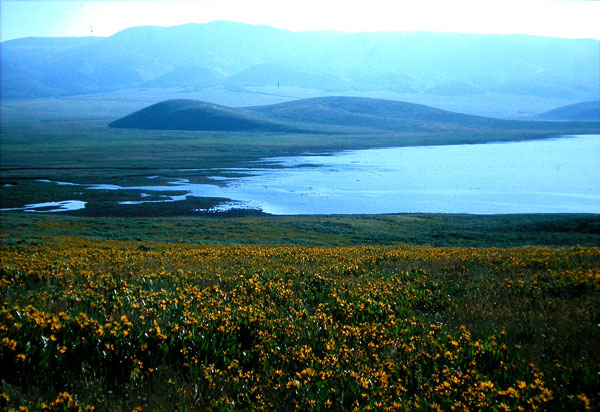 |
|
Strawberry Reservoir
photo by Merrill Webb |
9.
Strawberry Valley
Strawberry Valley in Wasatch County would be one of the first on my list
of "must visit" sites. This area not only has a lot of interesting
birds, and is only an hour's drive from Utah Valley, but it is a
beautiful area to visit, especially in the summer when a variety of
mountain wild flowers are in bloom. Centered in the middle of the
valley is Strawberry Reservoir, one of the most heavily fished bodies of
water in the state. But Strawberry also attracts large numbers of
nesting Western Grebe, hundreds of American White Pelican, and many
species of waterfowl. Gravel roads along tributaries such as Clyde
Creek, Mud Creek, Bryant's Fork, Indian Creek, Co-op Creek, and
Strawberry River provide access to a mixed variety of riparian and
forest birds such as Willow Flycatcher, Pine Grosbeak, Fox Sparrow,
House Wren, and if you are lucky, Three-toed Woodpecker and Northern
Goshawk. In the sagebrush-grass steppe Brewer's and Vesper Sparrows are
easy to observe. In the more moist areas Sandhill Crane and Savannah
Sparrows can be found.
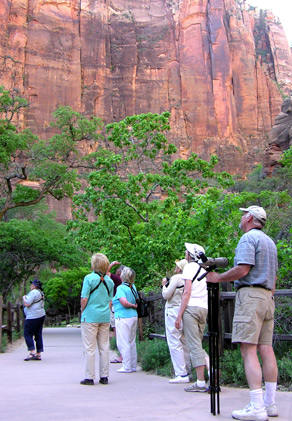 |
|
Birding at Zion NP
photo by Eric Huish |
10. Zion National Park
While enjoying spectacular scenery in the main canyon of Zion National
Park look for Plumbeous Vireo, Yellow Warbler, Black-headed Grosbeak and
the Peregrine Falcon which hunts from high vantage points overlooking
the canyon floor. Along the Narrow's Trail look for the Painted
Redstart, one of the few places in Utah where this species has nested
regularly in the last four years. Take a trail on the east side of the
mile-long tunnel and watch White-throated Swifts zip by at eye level and
listen for the cascading song of the Canyon Wren. Then take the East Rim
Trail through Ponderosa Pine parkland near the eastern boundary of the
park and watch for Hairy Woodpecker, Red-breasted Nuthatch, Pygmy
Nuthatch and the beautiful Grace's Warbler.
During the winter, if you should be inclined to visit when there
aren't hordes of visitors to contend with, Winter Wren has been found at
the waters associated with Weeping Rock. Watch for Dippers in the Virgin
River. And sometimes, near and around the campgrounds and visitor's
center Pygmy Owls have been found. There is a fee to enter the park, but
in my opinion it is worth it, at any time of the year.
|







